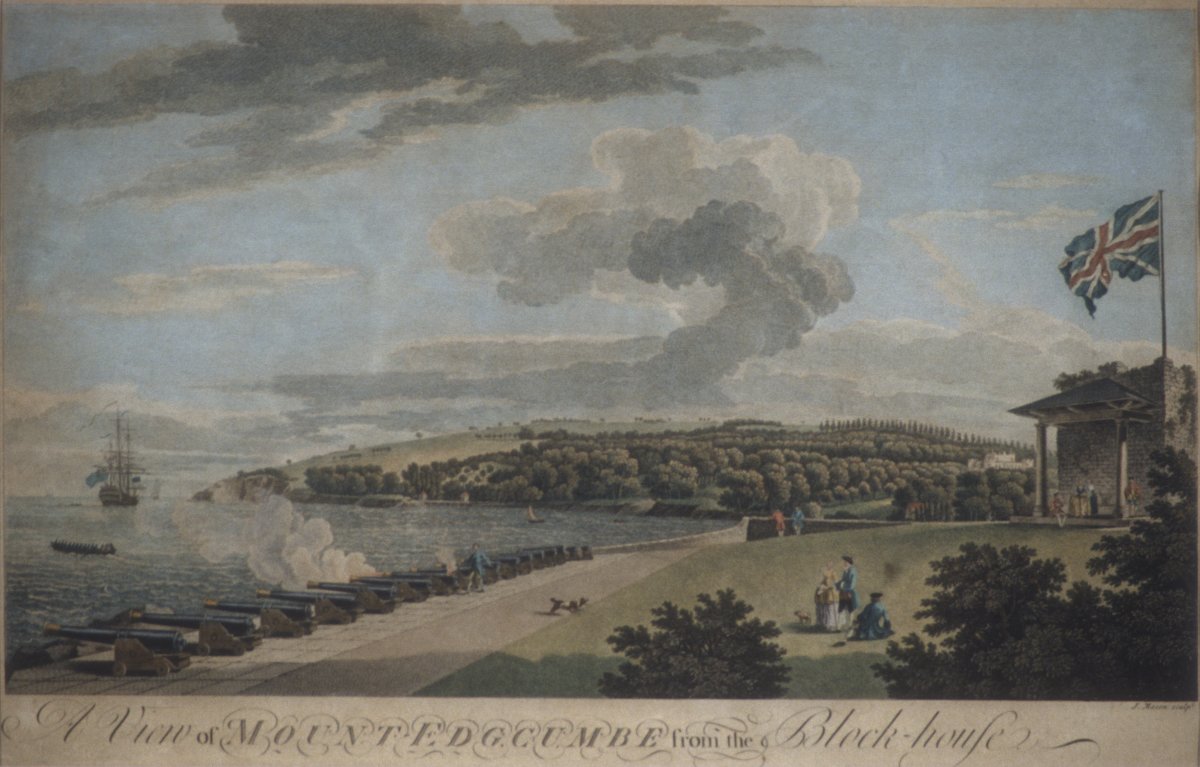A View of Mount Edgcumbe from the Block-House
George Lambert (c.1700 - 1765)
Samuel Scott (c.1702 - 1772)
James Mason (1710 - c.1780)
Coloured engraving
published 5 May 1755
-
About the work
- Location
-
Country: UK
City: London
Place: Government Art Collection
The Blockhouse at Plymouth was built in c.1545 as part of the maritime defense programmes of Henry VIII. Its purpose was as a defensive strong point, protecting the mouth of the River Tamar and the town of Stonehouse (now amalgamated into Plymouth) against attack.
This is the third of a series of engravings titled ‘Five Views of and from Mount Edgcumbe, Plymouth’, published in 1755. The prints are based on a series of paintings by George Lambert, which were produced at the painter’s studio-home in the Piazza at Covent Garden in London. It is thought that the figures were added to the landscapes by painter Samuel Scott. The series may have been commissioned by politician Richard, first Baron Edgcumbe or his son (also Richard), who served as Lord of the Admiralty in 1755-56. They were certainly owned by the family and were displayed at their home in Upper Grosvenor Street, Mayfair.
In 1757 Lambert advertised the set of engravings in the ‘London Evening Post’. The paintings were later transferred to the Edgcumbe’s country estate, Mount Edgcumbe in south-east Cornwall, where they were destroyed when Mount Edgcumbe House was gutted by fire during the Blitz.
-
About the artist
George Lambert, theatre scene and landscape painter, divided his career equally between the two professions. For most of his life he lived in Covent Garden. His early style of the 1720s is similar to that of John Wootton. However, his later classical landscapes earned him the accolade ‘the English Poussin’. Lambert painted the landscape backgrounds for William Hogarth’s paintings ‘The Pool of Bethesda’ and ‘The Good Samaritan’, made for St. Bartholomew’s Hospital (1736-37). In 1761 he was elected chairman of the newly founded Society of Artists of Great Britain. The Society received the Royal Seal on 26th January 1765 and just five days later Lambert died at his home in Covent Garden, leaving his possessions to his servant, Ann Terry.
Samuel Scott, marine and topographical painter, was born in London in c.1702. His early subjects were marine scenes and naval engagements, painted in the style of the van de Veldes. However, following Antonio Canaletto's visit to the capital in 1746, Scott was influenced by the growing popularity of the Venetian artist's views of London and the Thames and devoted himself almost exclusively to this subject. Scott's London views became particularly popular. Unlike other imitators of Canaletto, he avoided the Venetian artist's permanent Venetian blue skies. He settled in the fashionable writers' and artists' village of Twickenham but later moved to Bath, where he died.
Nothing is known about the early life of the landscape engraver James Mason. He is first mentioned by engraver and antiquary George Vertue, working for the publisher Arthur Pond in 1744, when he was probably in his early twenties. Mason later established himself as a popular engraver, co-publishing some of his own works. He produced several engravings after paintings by landscape and scene painter George Lambert, the majority of which are dated between 1745 and 1761. Mason engraved considerably less after 1780. He died in 1805 at his home in Winchester Row, Paddington, and was buried nearby at St Mary’s Church. He referred to himself as engraver and shopkeeper in his will, which suggests that he also ran a print shop.
-
Explore
- Places
- Subjects
- Materials & Techniques
-
Details
- Title
- A View of Mount Edgcumbe from the Block-House
- Date
- published 5 May 1755
- Medium
- Coloured engraving
- Dimensions
- height: 54.00 cm, width: 74.00 cm
- Acquisition
- Purchased from Parker Gallery, December 1963
- GAC number
- 6361